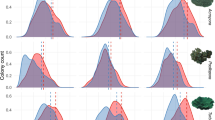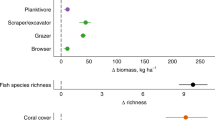Abstract
Changes in disturbance regimes due to climate change are increasingly challenging the capacity of ecosystems to absorb recurrent shocks and reassemble afterwards, escalating the risk of widespread ecological collapse of current ecosystems and the emergence of novel assemblages1,2,3. In marine systems, the production of larvae and recruitment of functionally important species are fundamental processes for rebuilding depleted adult populations, maintaining resilience and avoiding regime shifts in the face of rising environmental pressures4,5. Here we document a regional-scale shift in stock–recruitment relationships of corals along the Great Barrier Reef—the world’s largest coral reef system—following unprecedented back-to-back mass bleaching events caused by global warming. As a consequence of mass mortality of adult brood stock in 2016 and 2017 owing to heat stress6, the amount of larval recruitment declined in 2018 by 89% compared to historical levels. For the first time, brooding pocilloporids replaced spawning acroporids as the dominant taxon in the depleted recruitment pool. The collapse in stock–recruitment relationships indicates that the low resistance of adult brood stocks to repeated episodes of coral bleaching is inexorably tied to an impaired capacity for recovery, which highlights the multifaceted processes that underlie the global decline of coral reefs. The extent to which the Great Barrier Reef will be able to recover from the collapse in stock–recruitment relationships remains uncertain, given the projected increased frequency of extreme climate events over the next two decades7.
This is a preview of subscription content, access via your institution
Access options
Access Nature and 54 other Nature Portfolio journals
Get Nature+, our best-value online-access subscription
$29.99 / 30 days
cancel any time
Subscribe to this journal
Receive 51 print issues and online access
$199.00 per year
only $3.90 per issue
Buy this article
- Purchase on Springer Link
- Instant access to full article PDF
Prices may be subject to local taxes which are calculated during checkout



Similar content being viewed by others
Data availability
Source data on reef locations, adult coral abundance, recruit densities and coral reproductive condition before and after bleaching are available online at the Tropical Data Hub (https://tropicaldatahub.org/ with DOI: 10.25903/5c81fc323d129).
Code availability
Computer code for statistical analyses is available from the corresponding author on request.
References
Scheffer, M. et al. Creating a safe operating space for iconic ecosystems. Science 347, 1317–1319 (2015).
Johnstone, J. F. et al. Changing disturbance regimes, ecological memory, and forest resilience. Front. Ecol. Environ. 14, 369–378 (2016).
Hughes, T. P. et al. Coral reefs in the Anthropocene. Nature 546, 82–90 (2017).
Kleypas, J. A. et al. Larval connectivity across temperature gradients and its potential effect on heat tolerance in coral populations. Glob. Change Biol. 22, 3539–3549 (2016).
Holbrook, S. J. et al. Recruitment drives spatial variation in recovery rates of resilient coral reefs. Sci Rep. 8, 7338 (2018).
Hughes, T. P. et al. Global warming transforms coral reef assemblages. Nature 556, 492–496 (2018).
King, A. D., Karoly, D. J. & Henley, B. J. Australian climate extremes at 1.5 °C and 2 °C of global warming. Nat. Clim. Change 7, 412–416 (2017).
Hughes, T. P. et al. Spatial and temporal patterns of mass bleaching of corals in the Anthropocene. Science 359, 80–83 (2018).
Heron, S. F. et al. Impacts of Climate Change on World Heritage Coral Reefs: Update to the First Global Scientific Assessment. http://whc.unesco.org/en/news/1878 (UNESCO World Heritage Centre, 2018).
Figueiredo, J., Baird, A. H. & Connolly, S. R. Synthesizing larval competence dynamics and reef-scale retention reveals a high potential for self-recruitment in corals. Ecology 94, 650–659 (2013).
Ayre, D. J. & Hughes, T. P. Climate change, genotypic diversity and gene flow in reef-building corals. Ecol. Lett. 7, 273–278 (2004).
Underwood, J. N., Smith, L. D., van Oppen, M. J. H. & Gilmour, J. P. Ecologically relevant dispersal of corals on isolated reefs: implications for managing resilience. Ecol. Appl. 19, 18–29 (2009).
Baird, A. H., Guest, J. R. & Willis, B. L. Systematic and biogeographical patterns in the reproductive biology of scleractinian corals. Annu. Rev. Ecol. Evol. Syst. 40, 551–571 (2009).
Hughes, T. P. et al. Ecological memory modifies the cumulative impact of recurrent heatwaves. Nat. Clim. Change 9, 40–43 (2019).
Hughes, T. P. et al. Global warming and recurrent mass bleaching of corals. Nature 543, 373–377 (2017).
Connell, J. H. Disturbance and recovery of coral assemblages. Coral Reefs 16, S101–S113 (1997).
Osborne, K. et al. Delayed coral recovery in a warming ocean. Glob. Change Biol. 23, 3869–3881 (2017).
Connolly, S. R. & Baird, A. H. Estimating dispersal potential for marine larvae: dynamic models applied to scleractinian corals. Ecology 91, 3572–3583 (2010).
Figueiredo, J., Baird, A. H. & Connolly, S. R. Increased local retention of reef coral larvae as a result of ocean warming. Nat. Clim. Change 4, 498–502 (2014).
Matz, M. V., Treml, E. A., Aglyamova, G. V. & Bay, L. K. Potential and limits for rapid genetic adaptation to warming in a Great Barrier Reef coral. PLOS Genet. 14, e1007220 (2018).
Hock, K. et al. Connectivity networks reveal the risks of crown-of-thorns starfish outbreaks on the Great Barrier Reef. J. Appl. Ecol. 51, 1188–1196 (2014).
Howells, E. J., Berkelmans, R., van Oppen, M. J., Willis, B. L. & Bay, L. K. Historical thermal regimes define limits to coral acclimatization. Ecology 94, 1078–1088 (2013).
Hendry, A. P. Eco-Evolutionary Dynamics (Princeton Univ. Press, New Jersey, 2016).
Sweatman, H., Delean, S. & Syms, C. Assessing loss of coral cover on Australia’s Great Barrier Reef over two decades, with implications for longer term-trends. Coral Reefs 30, 521–531 (2011).
Loya, Y. et al. Coral bleaching: the winners and the losers. Ecol. Lett. 4, 122–131 (2001).
Álvarez-Noriega, M. et al. Contrasting patterns of changes in abundance following a bleaching event between juvenile and adult scleractinian corals. Coral Reefs 37, 527–532 (2018).
Gilmour, J. P., Smith, L. D., Heyward, A. J., Baird, A. H. & Pratchett, M. S. Recovery of an isolated coral reef system following severe disturbance. Science 340, 69–71 (2013).
Allen, M. et al. Special Report on Global Warming of 1.5 °C. http://www.ipcc.ch/report/sr15/ (IPCC, 2018).
Australian Institute of Marine Science. Long-Term Reef Monitoring Program: Annual Summary Report on Coral Reef Condition for 2017/18. https://www.aims.gov.au/reef-monitoring/gbr-condition-summary-2017–2018 (AIMS, 2018)
West, J. M. & Salm, R. V. Resistance and resilience to coral bleaching: implications for coral reef conservation and management. Conserv. Biol. 17, 956–967 (2003).
Hughes, T. P. et al. Patterns of recruitment and abundance of corals along the Great Barrier Reef. Nature 397, 59–63 (1999).
Bates, D., Maechler, M., Bolker, B. & Walker, S. Fitting linear mixed-effects models using lme4. J. Stat. Softw. 67, 1–48 (2015).
Baird, A. H. et al. Latitudinal variation in reproductive synchrony in Acropora assemblages: Japan vs Australia. Galaxea 11, 101–108 (2009).
Acknowledgements
We acknowledge support from the Australian Research Council’s Centre of Excellence Program (CE140100020). We thank the many dozens of student volunteers and technicians who assisted with this research over three decades.
Reviewer information
Nature thanks James Guest, Peter Sale and the other anonymous reviewer(s) for their contribution to the peer review of this work.
Author information
Authors and Affiliations
Contributions
The study was conceptualized by T.P.H., who also wrote the first draft of the paper. All authors contributed to fieldwork and to writing subsequent drafts. J.T.K. coordinated data compilation, analyses and graphics. S.R.C. and M.J. provided statistics and modelling advice.
Corresponding author
Ethics declarations
Competing interests
The authors declare no competing interests.
Additional information
Publisher’s note: Springer Nature remains neutral with regard to jurisdictional claims in published maps and institutional affiliations.
Extended data figures and tables
Extended Data Fig. 1 Frequency distribution of the density of coral recruits, before and after mass bleaching in 2016 and 2017.
In total, 1,784 settlement panels were deployed before mass bleaching (in 1996, 1997, 1998, 2004 and 2014–2016) on 47 reefs, and 977 panels on 17 reefs after mass bleaching in2017–2018. Figure 1 shows the reef locations.
Extended Data Fig. 2 Recruitment of corals over time.
The shared lettering (A–C) indicates recruit densities in each year that are statistically indistinguishable, based on an analysis of variance with Bonferroni-corrected Tukey’s post hoc test. Horizontal lines show the median, boxes indicate the middle two quartiles, vertical lines indicate the first and fourth quartiles, and data points are outliers. a, Box plots show recruit density per settlement panel (n = 30, 55, 44, 125, 126 and 118 panels in 1996, 1997, 1998, 2016, 2017 and 2018, respectively) on Lizard Island Reef in the northern Great Barrier Reef, before and after mass mortality of established corals in March 2016 (after the retrieval of settlement panels in January 2016). Most values for 2017 are zero, causing the box plots to collapse. b, Box plots show average recruit density per panel on the Great Barrier Reef in 1996, 1997 and 2018 (n = 15 reefs per year, in 5 latitudinal sectors). The same 15 reefs were resampled in 1996 and 2018; see Fig. 1c.
Extended Data Fig. 3 Vectors for non-metric multi-dimensional scaling analysis.
Related to Fig. 2b, showing the shift in the taxonomic composition of coral recruits.
Extended Data Fig. 4 Changes in the density of coral recruits as a function of the loss or gain of adult corals.
Data points represent the change in recruitment and coral cover, shown as log10(change in recruitment) and log10(change in cover), respectively, on each of five sectors arrayed along the length of the Great Barrier Reef. Blue lines represent the linear model fits and grey shading represents 95% confidence intervals. a, Spawners. b, Brooders. Figure 3 shows the reef-scale relationships.
Extended Data Fig. 5 Coral reproductive condition on the Great Barrier Reef before mass spawning in November 1995 and 2017.
Data in each year were collected from the same set of ten reefs in five latitudinal sectors. Horizontal lines show the median percentage of spawning Acropora corals that were gravid on each reef. Boxes indicate the middle two quartiles, vertical lines indicate the first and fourth quartiles. Reef locations are provided in the source data (available online at the Tropical Data Hub).
Supplementary information
Rights and permissions
About this article
Cite this article
Hughes, T.P., Kerry, J.T., Baird, A.H. et al. Global warming impairs stock–recruitment dynamics of corals. Nature 568, 387–390 (2019). https://doi.org/10.1038/s41586-019-1081-y
Received:
Accepted:
Published:
Issue Date:
DOI: https://doi.org/10.1038/s41586-019-1081-y
This article is cited by
-
Decadal demographic shifts and size-dependent disturbance responses of corals in a subtropical warming hotspot
Scientific Reports (2024)
-
Larval precompetency and settlement behaviour in 25 Indo-Pacific coral species
Communications Biology (2024)
-
Early post-settlement events, rather than settlement, drive recruitment and coral recovery at Moorea, French Polynesia
Oecologia (2024)
-
Changes of Phospholipid Molecular Species Profile Upon Bleaching and Subsequent Restoration of Coral Sinularia heterospiculata
Chemistry of Natural Compounds (2024)
-
Transient dynamics mask the resilience of coral reefs
Theoretical Ecology (2024)
Comments
By submitting a comment you agree to abide by our Terms and Community Guidelines. If you find something abusive or that does not comply with our terms or guidelines please flag it as inappropriate.



